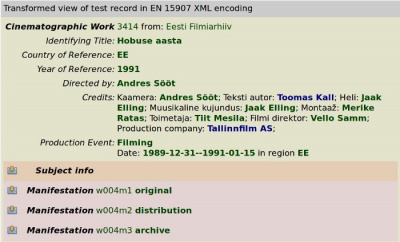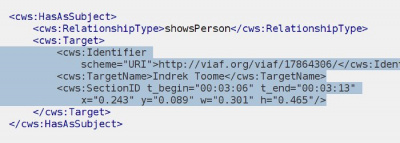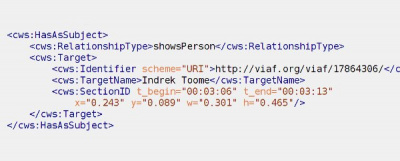Difference between revisions of "Approaching the subject of a film work"
From filmstandards.org
(→A worked example) |
|||
| (5 intermediate revisions by the same user not shown) | |||
| Line 11: | Line 11: | ||
<br /> | <br /> | ||
<span style="font-size:8pt"> | <span style="font-size:8pt"> | ||
| − | + | Excerpted from: Hobuse Aasta (1991) by Andres Sööt. Version with English commentary from Eesti Filmiarhiiv, Tallinn. Used with permission. | |
</span> | </span> | ||
| valign="top" width="405px" | | | valign="top" width="405px" | | ||
| − | This is a documentary about events in | + | This is a documentary about events in Estonia before the country gained independence from the Soviet Union in early 1991. The clip contains images from the parliamentary assembly of 26 January, 1990, in which an amendment of the constitution was attempted. |
| + | |||
| + | The '''content''' of this clip clearly '''focuses on people''', in this case on those that represented the leading political class in Estonia until 1990. | ||
| + | |||
| + | |} | ||
| + | |||
| + | {| style="float: right; border: 1px solid #BBB; margin: .46em 0 0 .2em;" | ||
| + | |- | ||
| + | | valign="top" width="405px" |[[File:Has-as-subject-p.jpg|400px]]<br /> | ||
| + | <span style="font-size:8pt"> | ||
| + | </span> | ||
| + | |||
| + | | valign="top" width="405px" | | ||
| + | The individuals depicted in the clip cannot be regarded as active contributors to the film work, since their activity would also have taken place in the absence of a camera. In cases where a person is not an ''Agent'' in the sense or our reference model, we can still construct relationships to persons or other agent entities by using the semantics of ''Subject''. | ||
| + | |||
| + | EN 15907 defines a '''HasAsSubject relationship''' for connecting any entity type (including film and non-film objects) to a cinematographic work. In this example, we refine this to a '''showsPerson''' relationship, using a specialisation from a corresponding type vocabulary. | ||
| + | |} | ||
| + | |||
| + | {| style="float: right; border: 1px solid #BBB; margin: .46em 0 0 .2em;" | ||
| + | |- | ||
| + | | valign="top" width="405px" |[[File:Hobuse-aasta-xmltrans.jpg|400px]]<br /> | ||
| + | <span style="font-size:8pt"> | ||
| + | </span> | ||
| + | |||
| + | | valign="top" width="405px" | | ||
| + | We now combine our HasAsSubject '''references''' with other forms of subject description, in this case, two '''synopses''' taken from published sources, and insert them into a filmographic record for ''Hobuse Aasta''. | ||
| + | |||
| + | The [http://filmstandards.org/demo/xml/transform.php?src=004/hobuse_aasta.xml transformed view] example groups all subject-related statements under a ''Subject info'' section (click on the symbol to open). Here is the [http://filmstandards.org/demo/xml/004/hobuse_aasta.xml raw XML code] for this example. | ||
| + | |} | ||
| + | |||
| + | {| style="float: right; border: 1px solid #BBB; margin: .46em 0 0 .2em;" | ||
| + | |- | ||
| + | | valign="top" width="405px" |[[File:Has-as-subject-ptarget.jpg|400px]]<br /> | ||
| + | <span style="font-size:8pt"> | ||
| + | </span> | ||
| + | |||
| + | | valign="top" width="405px" | | ||
| + | Taking a closer look at the '''Target element''' in the encoding of the subject reference, we see an '''identifier''' that links our filmographic record to an [http://viaf.org/viaf/17864306/ external resource]. Since viaf.org can supply information as [http://viaf.org/viaf/17864306/rdf.xml RDF data structures], this identifier reference can be readily utilised in a Linked Open Data (LOD) environment. | ||
| + | |||
| + | The '''SectionID''' element has several attributes defined in an extension to the core EN 15907 XML schema. These attributes define a spatio-temporal region in the cinematographic medium to which the subject reference applies. | ||
| + | |} | ||
| + | |||
| + | {| style="float: right; border: 1px solid #BBB; margin: .46em 0 0 .2em;" | ||
| + | |- | ||
| + | | valign="top" width="405px" | | ||
| + | <mediaplayer image='http://filmstandards.org/media/hobuse_aasta_frame_bw.png'>http://filmstandards.org/media/hobuse_aasta_clip1_mod.flv</mediaplayer> | ||
| + | <br /> | ||
| + | <span style="font-size:8pt"> | ||
| + | </span> | ||
| + | |||
| + | | valign="top" width="405px" | | ||
| + | This is a possible rendering of the '''SectionID attribute values''' as an overlay mask applied to the above clip. | ||
| + | |||
| + | Note that this example uses several different renderings for moving regions. In fact, the extended definition for SectionID is still incomplete, awaiting further input from the user community. The definition also lacks ways of expressing references to a particular manifestation of the film work in cases where these are known to have different durations. | ||
| + | |||
| + | Spatiotemporal regions can also be used for computing relevance factors for information retrieval. As an example, a film work can be assumed to be more relevant if a person of interest can be seen for longer periods of time and if it occupies larger areas on the screen. | ||
| + | |||
| + | The MPEG-7 standard defines highly elaborate data structures for describing spatiotemporal segments of moving images. To what extent these definitions should be adopted as extensions to EN 15907 is currently an open issue. | ||
| + | |} | ||
| + | |||
| + | {| height="20px" width="100%" | ||
| + | |- style="text-align:center; " | ||
| + | |<span style="color:#808080"> • Previous: [[Agent and event: Further examples]] • Up: [[TC 372 Workshop Compendium|Contents]] • Next: [[Common pitfalls in vocabulary selection]] • </span> | ||
| + | |- | ||
|} | |} | ||
Latest revision as of 12:30, 21 June 2011
From the TC 372 Workshop Compendium
A worked example
Documentary films are typically searched for by subject. While content description and keyword indexing are mainstay procedures in film cataloguing, today's networked environment allows for almost anything to be related to a cinematographic work in the role of subject.
|
<mediaplayer image='http://filmstandards.org/media/hobuse_aasta_frame.png'>http://filmstandards.org/media/hobuse_aasta_clip1_ori.flv</mediaplayer>
|
This is a documentary about events in Estonia before the country gained independence from the Soviet Union in early 1991. The clip contains images from the parliamentary assembly of 26 January, 1990, in which an amendment of the constitution was attempted. The content of this clip clearly focuses on people, in this case on those that represented the leading political class in Estonia until 1990. |

|
We now combine our HasAsSubject references with other forms of subject description, in this case, two synopses taken from published sources, and insert them into a filmographic record for Hobuse Aasta. The transformed view example groups all subject-related statements under a Subject info section (click on the symbol to open). Here is the raw XML code for this example. |

|
Taking a closer look at the Target element in the encoding of the subject reference, we see an identifier that links our filmographic record to an external resource. Since viaf.org can supply information as RDF data structures, this identifier reference can be readily utilised in a Linked Open Data (LOD) environment. The SectionID element has several attributes defined in an extension to the core EN 15907 XML schema. These attributes define a spatio-temporal region in the cinematographic medium to which the subject reference applies. |
|
<mediaplayer image='http://filmstandards.org/media/hobuse_aasta_frame_bw.png'>http://filmstandards.org/media/hobuse_aasta_clip1_mod.flv</mediaplayer>
|
This is a possible rendering of the SectionID attribute values as an overlay mask applied to the above clip. Note that this example uses several different renderings for moving regions. In fact, the extended definition for SectionID is still incomplete, awaiting further input from the user community. The definition also lacks ways of expressing references to a particular manifestation of the film work in cases where these are known to have different durations. Spatiotemporal regions can also be used for computing relevance factors for information retrieval. As an example, a film work can be assumed to be more relevant if a person of interest can be seen for longer periods of time and if it occupies larger areas on the screen. The MPEG-7 standard defines highly elaborate data structures for describing spatiotemporal segments of moving images. To what extent these definitions should be adopted as extensions to EN 15907 is currently an open issue. |
| • Previous: Agent and event: Further examples • Up: Contents • Next: Common pitfalls in vocabulary selection • |
